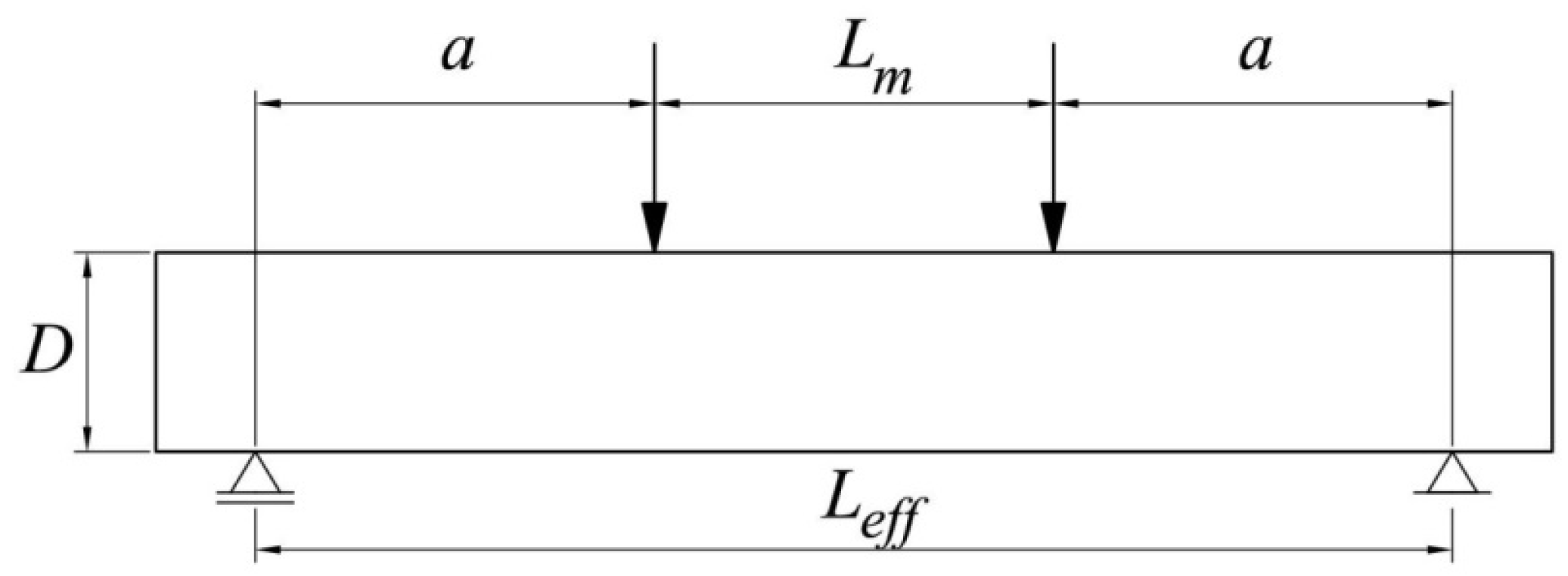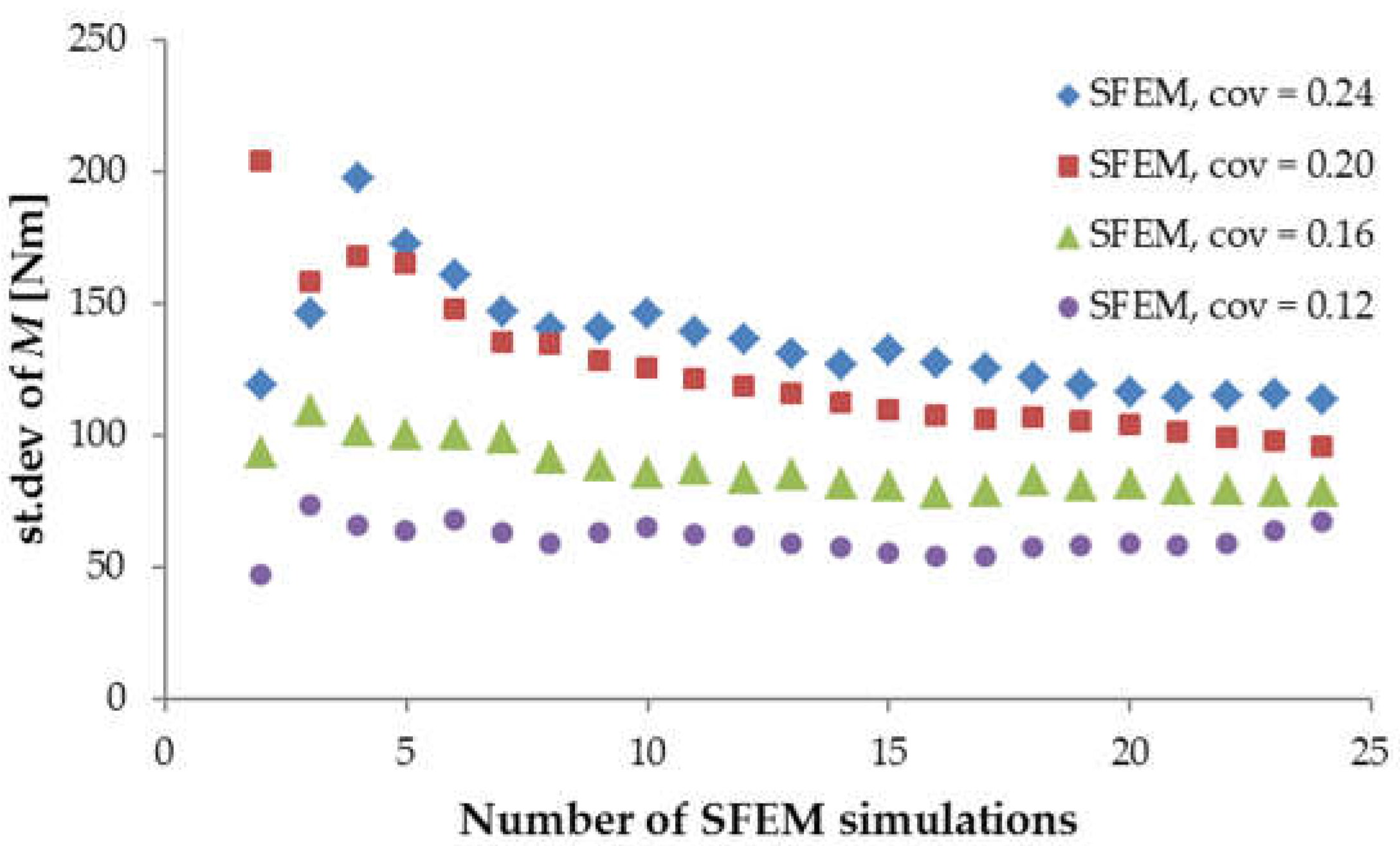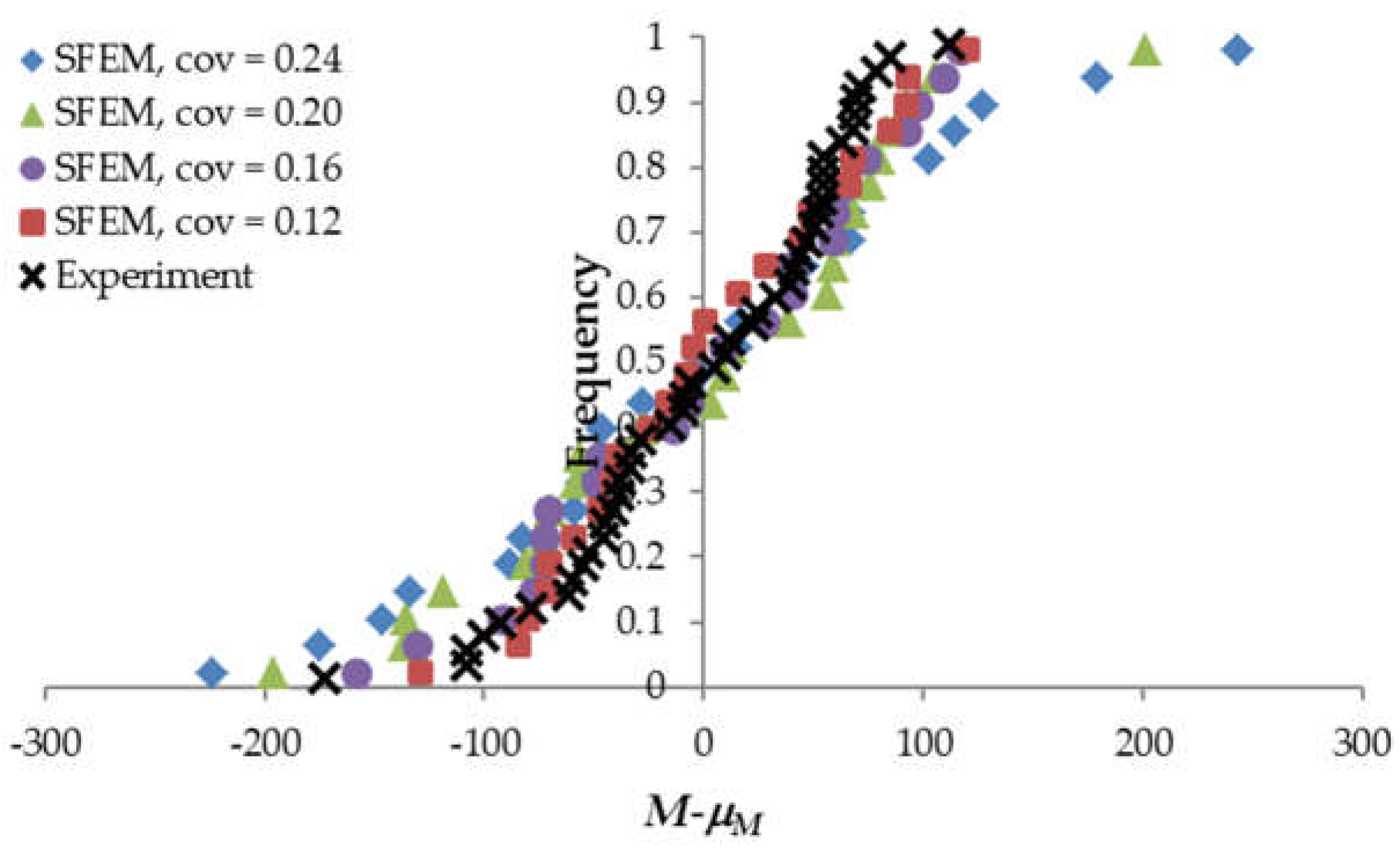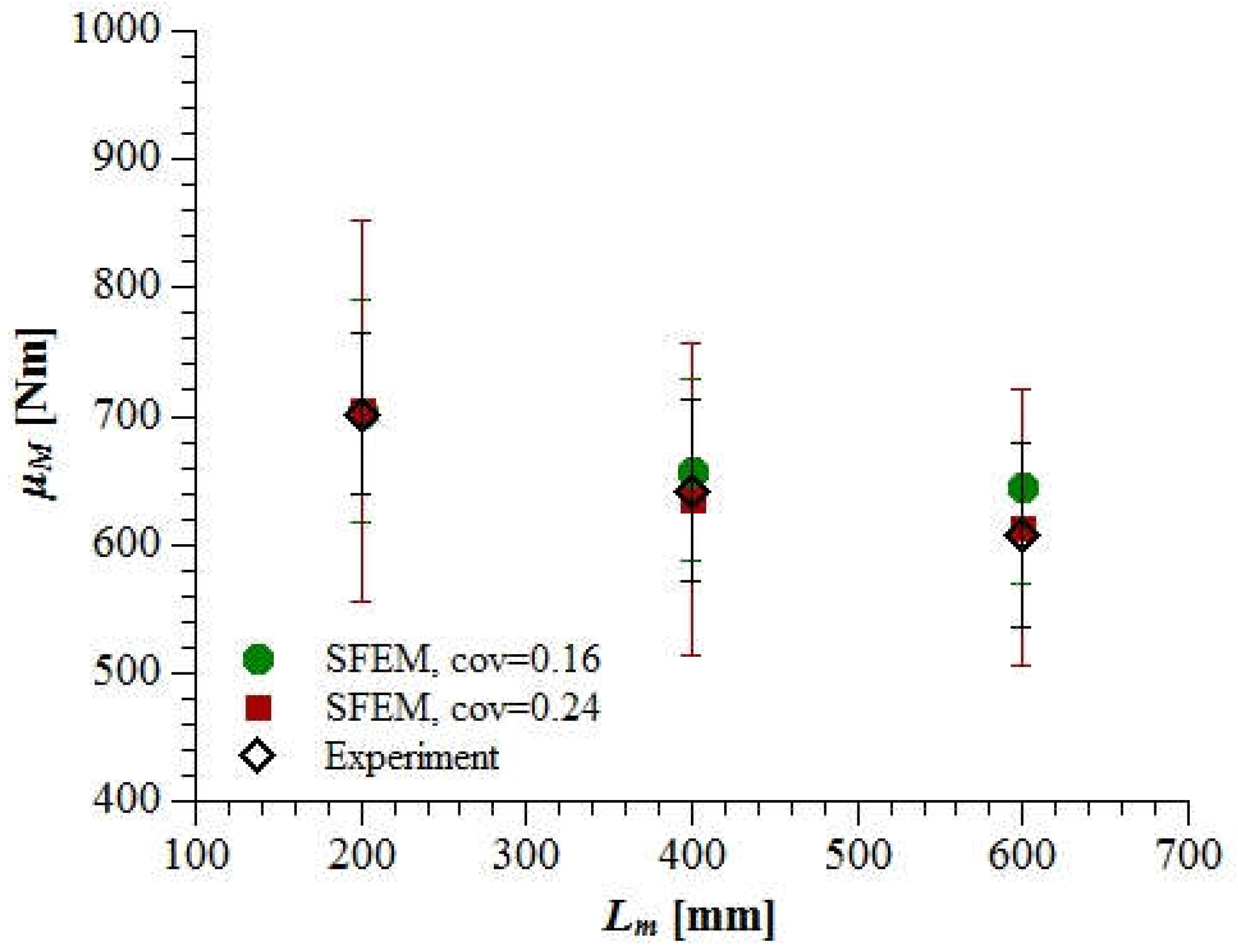SFEM Analysis of Beams with Scaled Lengths including Spatially Varying and Cross-Correlated Concrete Properties
Abstract
:1. Introduction
2. Materials and Methods
2.1. Constitutive Elasto-Plastic Model with Non-Local Softening
2.2. Random Fields
2.3. FE Input Data
3. Results
3.1. Convergence Study
3.2. Material and Stochastic Parameter Calibration
3.3. The Statistical Size Effect on the Beam Strength
4. Conclusions
- The spatial fluctuation of the local material properties was the source of the mean nominal strength reduction with an increasing beam length;
- The increasing material coefficient of variation cov contributed to the stronger statistical size effect on the mean nominal strength (i.e., the more pronounced reduction of the mean strength with the increasing beam length);
- The simulated statistical size effect with the material cov = 0.16, calibrated based on the bending moment variation of the shortest beam LM200, was too weak compared with the experimental results;
- Deterministic analysis showed the increase in the beam length (with the constant depth) caused the more brittle post-peak behavior but did not change the nominal strength.
Funding
Institutional Review Board Statement
Informed Consent Statement
Data Availability Statement
Conflicts of Interest
References
- Weibull, W. A statistical theory of the strength of materials. J. Appl. Mech. 1951, 18, 293–297. [Google Scholar] [CrossRef]
- Bazant, Z.P. Probability distribution of energetic-statistical size effect in quasi-brittle fracture. Probabilistic Eng. Mech. 2004, 19, 307–319. [Google Scholar] [CrossRef] [Green Version]
- Bazant, Z.P.; Planas, J. Fracture and Size Effect in Concrete and Other Quasi-Brittle Materials; CRC Press LLC: Boca Raton, FL, USA, 1998; pp. 1–640. [Google Scholar]
- Syroka-Korol, E.; Tejchman, J.; Mróz, Z. FE analysis of size effects in reinforced concrete beams without shear reinforcement based on stochastic elasto-plasticity with non-local softening. Finite Elem. Anal. Des. 2014, 88, 25–41. [Google Scholar] [CrossRef]
- Hoover, C.G.; Bazant, Z.P.; Vorel, J.; Wendner, R.; Hubler, M.H. Comprehensive concrete fracture tests: Description and results. Eng. Fract. Mech. 2013, 114, 92–103. [Google Scholar] [CrossRef]
- Vliet, M.; Mier, J. Experimental investigation of size effect in concrete and sandstone under uniaxial tension. Eng. Fract. Mech. 2000, 65, 165–188. [Google Scholar] [CrossRef]
- Koide, H.; Akita, H.; Tomon, M. Size Effect on Flexural Resistance due to Bending Span of Concrete Beams. In Proceedings of the Third International Conference on Fracture Mechanics of Concrete and Concrete Structures (FRAMCOS-3), Gifu, Japan, 12–16 October 1998; Aedificatio Publishers: Freiburg, Germany, 1998; pp. 2121–2130. [Google Scholar]
- Koide, H.; Akita, H.; Tomon, M. Probability Model of Flexural Resistance on Different Lengths of Concrete Beams. In Proceedings of the 8th International Conference on Application of Safety and Probability, Sydney, Australia, 12–15 December 2000; Balkema: Rotterdam, The Netherlands; pp. 1053–1057. [Google Scholar]
- Bazant, Z.P.; Novak, D. Stochastic Models for Deformation and Failure of Quasibrittle Structures: Recent Advances and New Directions. In Computational Modelling of Concrete Structures (Proc., EURO-C. Conf., St. Johann im Pongau, Austria); Bicanic, N., de Borst, R., Mang, H., Meschke, G., Eds.; Balkema Publishing: Lisse, The Netherlands, 2003; pp. 583–598. [Google Scholar]
- Grassl, P.; Bazant, Z.P. Random lattice-particle simulation of statistical size effect in quasi-brittle structures failing at crack initiation. J. Eng. Mech. 2009, 135, 85–92. [Google Scholar] [CrossRef] [Green Version]
- Syroka-Korol, E.; Tejchman, J.; Mróz, Z. FE investigations of the effect of fluctuating local tensile strength on coupled energetic–statistical size effect in concrete beams. Eng. Struct. 2015, 103, 239–259. [Google Scholar] [CrossRef]
- Le, J.-L.; Bazant, Z.P. Unified nano-mechanics based probabilistic theory of quasibrittle and brittle structures: II. Fatigue crack growth, lifetime and scaling. J. Mech. Phys. Solids 2011, 59, 1322–1337. [Google Scholar]
- Le, J.-L.; Bazant, Z.P. Unified nano-mechanics based probabilistic theory of quasibrittle and brittle structures: I. Strength, static crack growth, lifetime and scaling. J. Mech. Phys. Solids 2011, 59, 1291–1321. [Google Scholar] [CrossRef]
- Eliás, J.; Vorechovsky, M.; Skocek, J.; Bazant, Z.P. Stochastic discrete meso-scale simulations of concrete fracture: Comparison to experimental data. Eng. Fract. Mech. 2015, 135, 1–16. [Google Scholar] [CrossRef]
- Hoover, C.G.; Bazant, Z.P. Cohesive crack, size effect, crack band and work-of-fracture models compared to comprehensieve concrete fracture tests. Int. J. Fract. 2014, 187, 133–143. [Google Scholar] [CrossRef] [Green Version]
- Comite Euro-International du Beton. CEB–FIB Model Code 1990 for Concrete Structures; Thomas Telford Publishing: London, UK, 1993. [Google Scholar]
- European Committee for Standarization. EN-1992-1-1: 2004 Eurocode 2: Design of Concrete Structures—Part 1-1: General Rules and Rules for Buildings; CEN-CENELEC: Brussels, Belgium, 2008. [Google Scholar]
- Skarzynski, L.; Tejchman, J. Experimental investigation of fracture process zone using DIC in plain and reinforced concrete beams under bending. Strain 2013, 49, 521–543. [Google Scholar] [CrossRef]
- Jirasek, M.; Bazant, Z.P. Inelastic Analysis of Structures; John Wiley & Sons: Hoboken, NJ, USA, 2001. [Google Scholar]
- Phoon, K.K.; Huang, S.P.; Quek, S.T. Simulation of second-order processes using Karhunen–Loeve expansion. Comput. Struct. 2002, 80, 1049–1060. [Google Scholar] [CrossRef]
- Phoon, K.K.; Huang, S.P.; Quek, S.T. Implementation of Karhunen–Loeve expansion for simulation using a wavelet-Galerkin scheme. Probabilistic Eng. Mech. 2002, 17, 293–303. [Google Scholar] [CrossRef]
- Karhunen, K. Über lineare Methoden in der Wahrscheinlichkeitsrechnung. Ann. Acad. Sci. Fennicae Ser. A I Math. Phys. 1947, 37, 1–79. [Google Scholar]
- Loeve, M. Functions Aleatoires du Second Ordre. In Processus Stochastic et Mouvment Brownien; Levy, P., Ed.; Gauthier Villares: Paris, France, 1948. [Google Scholar]
- Vorechovsky, M. Simulation of simply cross correlated random fields by series expansion methods. Struct. Saf. 2008, 30, 337–363. [Google Scholar] [CrossRef] [Green Version]












Publisher’s Note: MDPI stays neutral with regard to jurisdictional claims in published maps and institutional affiliations. |
© 2021 by the author. Licensee MDPI, Basel, Switzerland. This article is an open access article distributed under the terms and conditions of the Creative Commons Attribution (CC BY) license (https://creativecommons.org/licenses/by/4.0/).
Share and Cite
Korol, E. SFEM Analysis of Beams with Scaled Lengths including Spatially Varying and Cross-Correlated Concrete Properties. Materials 2022, 15, 95. https://doi.org/10.3390/ma15010095
Korol E. SFEM Analysis of Beams with Scaled Lengths including Spatially Varying and Cross-Correlated Concrete Properties. Materials. 2022; 15(1):95. https://doi.org/10.3390/ma15010095
Chicago/Turabian StyleKorol, Ewelina. 2022. "SFEM Analysis of Beams with Scaled Lengths including Spatially Varying and Cross-Correlated Concrete Properties" Materials 15, no. 1: 95. https://doi.org/10.3390/ma15010095





